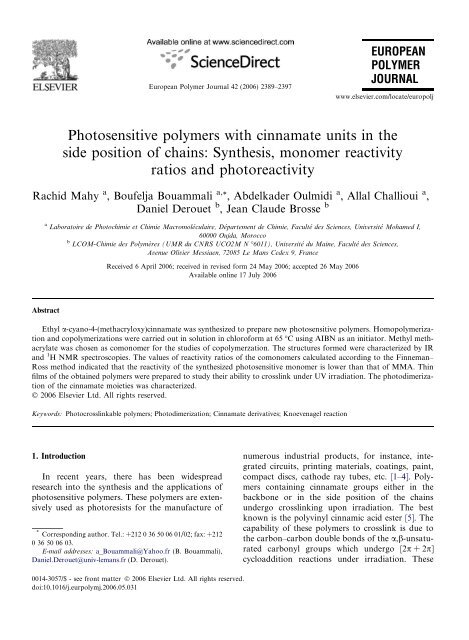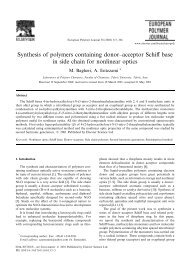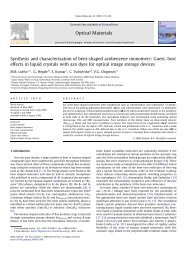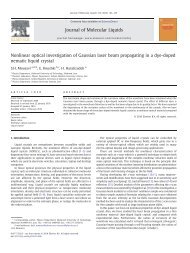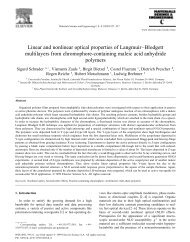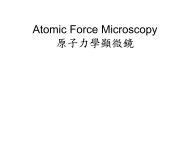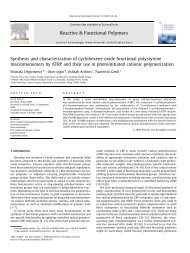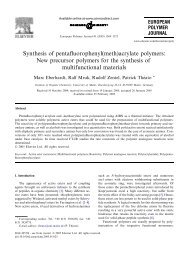Photosensitive polymers with cinnamate units in the side position of ...
Photosensitive polymers with cinnamate units in the side position of ...
Photosensitive polymers with cinnamate units in the side position of ...
Create successful ePaper yourself
Turn your PDF publications into a flip-book with our unique Google optimized e-Paper software.
<strong>Photosensitive</strong> <strong>polymers</strong> <strong>with</strong> <strong>c<strong>in</strong>namate</strong> <strong>units</strong> <strong>in</strong> <strong>the</strong><br />
<strong>side</strong> <strong>position</strong> <strong>of</strong> cha<strong>in</strong>s: Syn<strong>the</strong>sis, monomer reactivity<br />
ratios and photoreactivity<br />
Rachid Mahy a , Boufelja Bouammali a, *, Abdelkader Oulmidi a , Allal Challioui a ,<br />
Daniel Derouet b , Jean Claude Brosse b<br />
a Laboratoire de Photochimie et Chimie Macromoléculaire, Département de Chimie, Faculté des Sciences, Université Mohamed I,<br />
60000 Oujda, Morocco<br />
b LCOM-Chimie des Polymères (UMR du CNRS UCO2M N °6011), Université du Ma<strong>in</strong>e, Faculté des Sciences,<br />
Avenue Olivier Messiaen, 72085 Le Mans Cedex 9, France<br />
Abstract<br />
Received 6 April 2006; received <strong>in</strong> revised form 24 May 2006; accepted 26 May 2006<br />
Available onl<strong>in</strong>e 17 July 2006<br />
Ethyl a-cyano-4-(methacryloxy)<strong>c<strong>in</strong>namate</strong> was syn<strong>the</strong>sized to prepare new photosensitive <strong>polymers</strong>. Homopolymerization<br />
and copolymerizations were carried out <strong>in</strong> solution <strong>in</strong> chlor<strong>of</strong>orm at 65 °C us<strong>in</strong>g AIBN as an <strong>in</strong>itiator. Methyl methacrylate<br />
was chosen as comonomer for <strong>the</strong> studies <strong>of</strong> copolymerzation. The structures formed were characterized by IR<br />
and 1 H NMR spectroscopies. The values <strong>of</strong> reactivity ratios <strong>of</strong> <strong>the</strong> comonomers calculated accord<strong>in</strong>g to <strong>the</strong> F<strong>in</strong>neman–<br />
Ross method <strong>in</strong>dicated that <strong>the</strong> reactivity <strong>of</strong> <strong>the</strong> syn<strong>the</strong>sized photosensitive monomer is lower than that <strong>of</strong> MMA. Th<strong>in</strong><br />
films <strong>of</strong> <strong>the</strong> obta<strong>in</strong>ed <strong>polymers</strong> were prepared to study <strong>the</strong>ir ability to crossl<strong>in</strong>k under UV irradiation. The photodimerization<br />
<strong>of</strong> <strong>the</strong> <strong>c<strong>in</strong>namate</strong> moieties was characterized.<br />
Ó 2006 Elsevier Ltd. All rights reserved.<br />
Keywords: Photocrossl<strong>in</strong>kable <strong>polymers</strong>; Photodimerization; C<strong>in</strong>namate derivatives; Knoevenagel reaction<br />
1. Introduction<br />
European Polymer Journal 42 (2006) 2389–2397<br />
In recent years, <strong>the</strong>re has been widespread<br />
research <strong>in</strong>to <strong>the</strong> syn<strong>the</strong>sis and <strong>the</strong> applications <strong>of</strong><br />
photosensitive <strong>polymers</strong>. These <strong>polymers</strong> are extensively<br />
used as photoresists for <strong>the</strong> manufacture <strong>of</strong><br />
*<br />
Correspond<strong>in</strong>g author. Tel.: +212 0 36 50 06 01/02; fax: +212<br />
036500603.<br />
E-mail addresses: a_Bouammali@Yahoo.fr (B. Bouammali),<br />
Daniel.Derouet@univ-lemans.fr (D. Derouet).<br />
0014-3057/$ - see front matter Ó 2006 Elsevier Ltd. All rights reserved.<br />
doi:10.1016/j.eurpolymj.2006.05.031<br />
EUROPEAN<br />
POLYMER<br />
JOURNAL<br />
www.elsevier.com/locate/europolj<br />
numerous <strong>in</strong>dustrial products, for <strong>in</strong>stance, <strong>in</strong>tegrated<br />
circuits, pr<strong>in</strong>t<strong>in</strong>g materials, coat<strong>in</strong>gs, pa<strong>in</strong>t,<br />
compact discs, cathode ray tubes, etc. [1–4]. Polymers<br />
conta<strong>in</strong><strong>in</strong>g <strong>c<strong>in</strong>namate</strong> groups ei<strong>the</strong>r <strong>in</strong> <strong>the</strong><br />
backbone or <strong>in</strong> <strong>the</strong> <strong>side</strong> <strong>position</strong> <strong>of</strong> <strong>the</strong> cha<strong>in</strong>s<br />
undergo crossl<strong>in</strong>k<strong>in</strong>g upon irradiation. The best<br />
known is <strong>the</strong> polyv<strong>in</strong>yl c<strong>in</strong>namic acid ester [5]. The<br />
capability <strong>of</strong> <strong>the</strong>se <strong>polymers</strong> to crossl<strong>in</strong>k is due to<br />
<strong>the</strong> carbon–carbon double bonds <strong>of</strong> <strong>the</strong> a,b-unsaturated<br />
carbonyl groups which undergo [2p +2p]<br />
cycloaddition reactions under irradiation. These
2390 R. Mahy et al. / European Polymer Journal 42 (2006) 2389–2397<br />
O<br />
HO C<br />
H<br />
H 3C<br />
H 2C<br />
CN<br />
CO 2Et<br />
photosensitive <strong>polymers</strong> are regarded as negativetype<br />
photoresists [6,7].<br />
The substitution <strong>of</strong> <strong>the</strong> double bond <strong>of</strong> <strong>c<strong>in</strong>namate</strong><br />
group can affect its photosensitivity. It was<br />
reported that <strong>the</strong> <strong>with</strong>draw<strong>in</strong>g groups such as cyano<br />
group at <strong>the</strong> a-<strong>position</strong> <strong>of</strong> carbonyl function<br />
enhances <strong>the</strong> photoreactivity <strong>of</strong> <strong>c<strong>in</strong>namate</strong> unit [8].<br />
Brosse et al. [9] and Remmas et al. [10,11] have<br />
prepared and tested for photosensitivity different<br />
polystyrenic <strong>polymers</strong> <strong>with</strong> pendant <strong>c<strong>in</strong>namate</strong><br />
groups substituted on a-<strong>position</strong> by carboxylate<br />
and cyano groups.<br />
This article deals <strong>with</strong> <strong>the</strong> syn<strong>the</strong>sis <strong>of</strong> new monomer<br />
[Ethyl a-cyano-4-(methacryloxy)<strong>c<strong>in</strong>namate</strong>],<br />
its polymerization and copolymerization <strong>with</strong><br />
C<br />
O<br />
CH 2<br />
+<br />
O<br />
piperid<strong>in</strong>e<br />
(pyrid<strong>in</strong>e)<br />
CN<br />
CH C<br />
CO2Et methyl methacrylate (Schemes 1 and 2). Monomer<br />
reactivity ratios and <strong>the</strong> ability to crossl<strong>in</strong>k <strong>of</strong> <strong>the</strong><br />
obta<strong>in</strong>ed <strong>polymers</strong> under UV irradiation were also<br />
<strong>in</strong>vestigated.<br />
2. Experimental<br />
2.1. Materials<br />
CN<br />
HO CH C<br />
CO2Et 1 2 3 (80 %)<br />
4 (75 %)<br />
1) Et 3 N / CH 2 Cl 2<br />
2) H 2 C=C(CH 3 )-COCl<br />
Scheme 1. Syn<strong>the</strong>sis <strong>of</strong> ethyl a-cyano-4-hydroxy<strong>c<strong>in</strong>namate</strong> 3 and ethyl a-cyano-4-(methacryloxy)<strong>c<strong>in</strong>namate</strong> 4.<br />
H 2C<br />
C<br />
EtO 2 C<br />
CH 3<br />
4<br />
C<br />
O<br />
CH<br />
C<br />
O<br />
CN<br />
+<br />
MMA<br />
AIBN/ CHCl 3<br />
65ºC<br />
CH 2<br />
EtO 2 C<br />
C<br />
C<br />
O<br />
HC<br />
CH 3<br />
C<br />
CN<br />
p<br />
CH 2<br />
5 :Homopolymer (q=0)<br />
6 : Copolymer<br />
Scheme 2. Syn<strong>the</strong>sis <strong>of</strong> photosensitive homo- and co-<strong>polymers</strong> com<strong>in</strong>g from 4.<br />
O<br />
C<br />
q<br />
CO2CH3 Solvents were distilled before use accord<strong>in</strong>g to<br />
<strong>the</strong> procedures described <strong>in</strong> Perr<strong>in</strong> book [12] p-<br />
Hydrobenzaldehyde and AIBN were recrystallized<br />
<strong>in</strong> methanol. Methyl methacrylate was purified as<br />
follows: after wash<strong>in</strong>g twice <strong>with</strong> an aqueous solution<br />
<strong>of</strong> NaHCO3 (5%), and <strong>the</strong>n twice <strong>with</strong> water,<br />
CH 3
it was dried over Na2SO4, and f<strong>in</strong>ally <strong>the</strong> dried filtrate<br />
was distillated under reduced pressure. Methacryloyl<br />
chloride was purified by distillation under<br />
vacuum. Ethyl cyanoacetate was used as received.<br />
2.2. Apparatus<br />
Melt<strong>in</strong>g po<strong>in</strong>ts were determ<strong>in</strong>ed on a Bütchi<br />
apparatus. UV spectra were carried out on a Varian<br />
spectrophotometer (Cary W<strong>in</strong> UV B1O 100/300).<br />
Infrared spectra were recorded on a Perk<strong>in</strong>–Elmer<br />
1750 Fourier-transform spectrometer. 1 H and 13 C<br />
NMR spectra were recorded on Avance DPX200<br />
or Bruker AC 400 operat<strong>in</strong>g at 400.13 MHz for<br />
1 H and 100 MHz for 13 C<strong>in</strong>CDCl3 or DMSO-d 6<br />
<strong>with</strong> tetramethylsilane (TMS) as <strong>in</strong>ternal reference.<br />
The weight- and number-average molecular weights<br />
were determ<strong>in</strong>ed by Size Exlusion Chromatography<br />
(SEC) on a Spectra SYSTEM AS1000 autosampler<br />
system, equipped <strong>with</strong> a guard column (Polymer<br />
Laboratories, PL gel 5 lm Guard, 50 · 7.5 mm)<br />
and two columns (Polmer Laboratories, 2 PL gel<br />
5 lm MIXED-D columns, 300 · 7.5 mm) connected<br />
<strong>in</strong> series, and a Spectra SYSTEM RI-150 detector.<br />
Analyses were performed at 35 °C. THF was used<br />
as mobile phase at a flow rate <strong>of</strong> 1 ml m<strong>in</strong> 1 . The<br />
system was calibrated us<strong>in</strong>g low polydispersity polystyrene<br />
standards (483–580 · 10 3 g mol 1 ). The<br />
photocrossl<strong>in</strong>k<strong>in</strong>g studies were peformed us<strong>in</strong>g a<br />
B100A Ultraviolet lamp emitt<strong>in</strong>g from 300 to<br />
400 nm (100 w; k max = 365 nm).<br />
2.3. Syn<strong>the</strong>sis <strong>of</strong> ethyl a-cyano-4-hydroxy<strong>c<strong>in</strong>namate</strong> 3<br />
A pyrid<strong>in</strong>e solution (7.5 ml) <strong>of</strong> p-hydoxybenzaldehyde<br />
1 (25 mmol), ethyl cyanoacetate 2 (25 mmol)<br />
and piperid<strong>in</strong>e (2 drops) was refluxed for 1 h <strong>in</strong> a<br />
round bottom flask fitted <strong>with</strong> a condenser. Then,<br />
<strong>the</strong> solution was poured drop by drop <strong>in</strong>to a flask<br />
conta<strong>in</strong><strong>in</strong>g 100 ml <strong>of</strong> water and 25 g <strong>of</strong> crushed ice.<br />
The mixture was stirred until a product <strong>in</strong> suspension<br />
was formed. The precipitated material was filtered,<br />
washed <strong>with</strong> water, and <strong>the</strong>n recrystallized <strong>in</strong><br />
ethanol. Yield: 80%; mp 173 °C; IR (KBr): 3299<br />
(OH), 2228 (C„N), 1714 (C@O), 1612 (C@sC); 1 H<br />
NMR (400 MHz, DMSO-d 6): d (ppm) 8.17 (s, 1H,<br />
HC@C), 7.95 (d, J = 11.4 Hz, 2H, Ar–H 2,6), 6.90<br />
(d, J = 11.4 Hz, 2H, Ar–H 3,5), 4.25 (q, J = 7.2<br />
HZ, 2H, CH3–CH2–O), 1.27 (t, J = 7.2 Hz, 3H,<br />
CH3–CH2–O); 13 C NMR (100 MHz, DMSO-d6): d<br />
(ppm) 164.1 (CO2Et), 162.6 (C4), 154.4 (CH@C),<br />
133.8 (C2 and C6), 122.0 (C1), 116.6 (C3 and C5),<br />
R. Mahy et al. / European Polymer Journal 42 (2006) 2389–2397 2391<br />
116.6 (CN), 98.4 (CH=C), 63.0 (CH3–CH2–O),<br />
13.9 (CH3-CH2–O).<br />
2.4. Syn<strong>the</strong>sis <strong>of</strong> a-cyano-4-(methacryloxy)<strong>c<strong>in</strong>namate</strong><br />
4<br />
A solution <strong>of</strong> 3 (0.012 mol) <strong>in</strong> dichloromethane<br />
(12 ml) was <strong>in</strong>troduced <strong>in</strong> a three necked roundbottom<br />
flask and cooled at 0 °C us<strong>in</strong>g an ice bath.<br />
Solutions <strong>of</strong> methacryloyl chloride (0.018 mol)<br />
<strong>in</strong> dichloromethane (6 ml) and triethylam<strong>in</strong>e<br />
(0.018 mol) <strong>in</strong> dichloromethane (6 ml) were added<br />
simultaneously and dropwise from tow dropp<strong>in</strong>g<br />
funnels <strong>in</strong>to <strong>the</strong> stirred mixture. At <strong>the</strong> end <strong>of</strong> addition,<br />
<strong>the</strong> ice bath was removed and <strong>the</strong> stirr<strong>in</strong>g was<br />
ma<strong>in</strong>ta<strong>in</strong>ed for 12 h at room temperature. The<br />
formed triethylammonium chloride was filtered <strong>of</strong>f<br />
and <strong>the</strong> filtrate was washed twice <strong>with</strong> a solution<br />
<strong>of</strong> sodium bicarbonate, twice <strong>with</strong> water, and <strong>the</strong>n<br />
dried over sodium sulfate. F<strong>in</strong>ally, <strong>the</strong> solvent <strong>of</strong><br />
<strong>the</strong> dried filtrate was evaporated under reduce pressure<br />
and <strong>the</strong> crude product was recrystallized <strong>in</strong> ethanol.<br />
Yield: 75%; mp: 109 °C; IR (KBr): 2223<br />
(C„N), 1743 and 1716 (C@O), 1614 (C@C); 1 H<br />
NMR (400 MHz, DMSO-d6): d (ppm) 8.25 (s, 1H,<br />
HC@C), 8.05 (d, J = 11.4 Hz, 2H, Ar–H2,6), 7.30<br />
(d, J = 11.4 Hz, 2H, Ar–H3,5), 6.40 and 5.8 (s, 2H,<br />
H2C@C methacrylate), 4.38 (q, J = 7.2 Hz, 2H,<br />
CH3–CH2–O), 2.09 (s, 3H, CH3–CO), 1.42 (t,<br />
J = 7.2 Hz, 3H, CH 3–CH 2–O);<br />
13 C NMR<br />
(100 MHz, DMSO-d 6): d (ppm) 164.3 (CO 2Et),<br />
161.6 (CO-methacrylate), 153.8 (C4), 152.9<br />
(CH@C), 134.6 (H2C@C-methacrylate), 131.8 (C2<br />
and C6), 128.1 (C1), 127.4 (H2C@C methacrylate),<br />
121.8 (C3 and C5), 114.6 (CN), 101.9 (CH@C),<br />
62.0 (CH3–CH2–O), 17.5 (CH3-methacrylate), 13.3<br />
(CH 3–CH 2–O).<br />
2.5. Syn<strong>the</strong>sis <strong>of</strong> homopolymer 5<br />
In a round-bottom flask fitted <strong>with</strong> a condenser<br />
were <strong>in</strong>troduced 0.23 mmol <strong>of</strong> monomer 4, 5 ml <strong>of</strong><br />
chlor<strong>of</strong>orm, and 0.023 mmol <strong>of</strong> AIBN (1% compared<br />
to 4). The mixture was swept by nitrogen,<br />
and <strong>the</strong>n heated at 65 °C. After <strong>the</strong> required time<br />
(8 h), <strong>the</strong> obta<strong>in</strong>ed mixture was poured <strong>in</strong> a large<br />
excess <strong>of</strong> methanol (20 ml). The precipitated polymer<br />
was washed <strong>with</strong> methanol, <strong>the</strong>n purified by<br />
repeated reprecipitation <strong>in</strong>to methanol from solution<br />
<strong>in</strong> chlor<strong>of</strong>orm, and f<strong>in</strong>ally dried under vacuum.<br />
Yield: 92%; IR (KBr): 2225 (C„N), 1756 and 1716<br />
1<br />
(C@O), 1613 (C@C); H NMR (400 MHz,
2392 R. Mahy et al. / European Polymer Journal 42 (2006) 2389–2397<br />
DMSO-d6): d (ppm) 8.2 (1H, HC@C), 8.0 (2H, Ar–<br />
H2,6), 7.1 (2H, Ar–H3,5), 4.4 (2H, CH3–CH2–O),<br />
0.5–2.2 (backbone protons and CH3–CH2–O–).<br />
2.6. Syn<strong>the</strong>sis <strong>of</strong> co<strong>polymers</strong> 6<br />
Five copolymerization experiments were performed<br />
us<strong>in</strong>g 4 and MMA as comonomer. Various<br />
monomer molar ratios (20/80, 30/70, 50/50, 70/30<br />
and 80/20) were con<strong>side</strong>red. Appropriate amounts<br />
<strong>of</strong> monomers (total concentration = 0.47 mol l 1 ),<br />
<strong>in</strong>itiator (AIBN, 1% compared to 4), and chlor<strong>of</strong>orm<br />
(5 ml) were <strong>in</strong>troduced <strong>in</strong> a round-bottom<br />
flask fitted <strong>with</strong> a condenser. The mixture was<br />
placed under nitrogen atmosphere, and <strong>the</strong>n stirred<br />
at 65 °C for 8 h. The formed copolymer was purified<br />
accord<strong>in</strong>g to <strong>the</strong> same procedure as for <strong>the</strong> homopolymer.<br />
Poly(4-co-MMA) 6: Yield: 60–95%; IR<br />
(KBr): 2224 (C„N), 1750 and 1716 (C@O), 1613<br />
(C@C); 1 H NMR (400 MHz, CDCl3): d (ppm) 8.3<br />
(1H, HC@C–), 8.1 (2H, Ar–H 2, 6), 7.3 (2H, Ar–<br />
H 3,5), 4.4 (2H, CH 3–CH 2–O–), 3.6 (3H, –CO 2CH 3),<br />
0.8–2.3 (backbone protons and CH 3–CH 2–O–).<br />
2.7. Photoreactivity measurements<br />
The photochemical reactivity <strong>of</strong> <strong>the</strong> syn<strong>the</strong>sized<br />
homo- and co-<strong>polymers</strong> was measured as follows:<br />
The copolymer solution <strong>in</strong> THF was cast on a<br />
quartz plate and dried under vacuum at 40 °C for<br />
1 h. After dry<strong>in</strong>g, <strong>the</strong> film formed on <strong>the</strong> plate was<br />
irradiated us<strong>in</strong>g <strong>the</strong> B100A Ultraviolet lamp placed<br />
at a distance <strong>of</strong> 5 cm for different time <strong>in</strong>tervals.<br />
After each exposure <strong>in</strong>terval, UV and IR spectra<br />
<strong>of</strong> <strong>the</strong> sample were recorded, and <strong>the</strong> photocrossl<strong>in</strong>k<strong>in</strong>g<br />
rate was determ<strong>in</strong>ed by follow<strong>in</strong>g <strong>the</strong> <strong>in</strong>tensity<br />
decrease <strong>of</strong> <strong>the</strong> <strong>c<strong>in</strong>namate</strong> absorption band<br />
(310 nm and 1613 cm 1 , respectively, for UV and<br />
IR).<br />
3. Results and discussion<br />
3.1. Preparation <strong>of</strong> ethyl a-cyano-4hydroxy<strong>c<strong>in</strong>namate</strong><br />
3 and a-cyano-4-<br />
(methacryloxy)<strong>c<strong>in</strong>namate</strong> 4<br />
Compound 3 was prepared by Knoevenagel condensation<br />
<strong>of</strong> p-hydroybenzaldehyde 1 <strong>with</strong> ethyl<br />
cyanoacetate 2 <strong>in</strong> presence <strong>of</strong> piperid<strong>in</strong>e as a basic<br />
catalyst. Then 3 was esterified by methacryloyl chloride<br />
<strong>in</strong> presence <strong>of</strong> triethylam<strong>in</strong>e to give <strong>the</strong> methacrylate<br />
monomer 4 (Scheme 1).<br />
3 and 4 were obta<strong>in</strong>ed <strong>in</strong> good yields (80% and<br />
75%, respectively) and <strong>the</strong> analytical data (see Section<br />
2) fully supported <strong>the</strong> structure <strong>of</strong> 3 and 4.<br />
3.2. Homopolymerization <strong>of</strong> 4<br />
Radical homopolymerization <strong>of</strong> 4 was <strong>in</strong>itiated<br />
<strong>with</strong> azoisobutyronitrile (AIBN). It was performed<br />
at 65 °C <strong>in</strong> chlor<strong>of</strong>orm (Scheme 2). After 8 h <strong>of</strong><br />
reaction, polymer 5 was obta<strong>in</strong>ed <strong>in</strong> 92% yield. It<br />
showed good solubility <strong>in</strong> butanone, THF, CH2Cl2,<br />
CHCl3, benzene, toluene, DMF and dioxane.<br />
The weight- and number-average molecular<br />
weights <strong>of</strong> 9600 and 6200, respectively, were determ<strong>in</strong>ed<br />
by SEC. The value <strong>of</strong> polydispersity <strong>in</strong>dex<br />
(I = 1.7) which is close to 2, suggests a tendency<br />
for cha<strong>in</strong> term<strong>in</strong>ation by dispropotionation.<br />
Homopolymer 5 was characterized by IR and 1 H<br />
NMR. In IR, strong absorption bands characteristic<br />
<strong>of</strong> <strong>the</strong> carbonyles <strong>of</strong> methacrylate and <strong>c<strong>in</strong>namate</strong><br />
functions were noted at 1756 cm 1 and<br />
1716 cm 1 , respectively. A weak absorption band<br />
at 1613 cm 1 was attributed to CH@C unsaturations.<br />
An absorption band at 1595 cm 1 was<br />
assigned to aromatic C@C stretch<strong>in</strong>g vibration.<br />
The 1 H NMR spectrum <strong>of</strong> 5 shows resonances at<br />
d = 8.0 and 7.1 ppm due to aromatic protons. The<br />
proton <strong>of</strong> <strong>the</strong> CH=C unsaturations is noted at<br />
d = 8.2 ppm. Signal at d = 4.4 ppm corresponds to<br />
CH2 protons <strong>of</strong> ethoxy groups. The CH3 protons<br />
<strong>of</strong> ethoxy groups and <strong>the</strong> backbone protons rise at<br />
0.5–2.2 ppm (Fig. 1).<br />
A progress <strong>of</strong> 4 polymerization performed <strong>in</strong><br />
deuterated chlor<strong>of</strong>orm was followed by 1 H NMR<br />
(Fig. 2). The <strong>in</strong>corporation <strong>of</strong> monomer 4 <strong>in</strong> polymer<br />
was determ<strong>in</strong>ed form 1 H NMR spectra by compar<strong>in</strong>g<br />
<strong>the</strong> relative <strong>in</strong>tensities <strong>of</strong> <strong>the</strong> methacrylic<br />
methylene protons <strong>of</strong> <strong>the</strong> residual monomer<br />
(d = 6.40 and 5.80 ppm) to protons at d = 7.8 and<br />
8.5 ppm (CH@C and Ar–H2,6) <strong>of</strong> both residual<br />
monomer and monomer <strong>in</strong>corporated <strong>in</strong> polymer.<br />
Accord<strong>in</strong>g to <strong>the</strong> general equation <strong>of</strong> <strong>the</strong> polymerization<br />
rate [13] (Eq. (1)), <strong>the</strong> kp= ffiffiffiffi p<br />
kt ratios were<br />
calculated (kd = 2.53 10 5 s 1 determ<strong>in</strong>ed at 65 °C<br />
and f = 0.5 [14]).<br />
ffiffiffiffi<br />
kt<br />
p<br />
Ln½M 0Š=½M tŠ ¼ðkp=<br />
pffiffiffiffiffiffiffiffiffiffiffiffiffiffiffiffiffiffi<br />
Þ 2 2f ½I 0Š=kd:<br />
½1 expð kd t=2ÞŠ ð1Þ<br />
where [M0] and [Mt] are <strong>the</strong> monomer concentrations<br />
at times 0 and t, respectively, and [I0] is <strong>the</strong> <strong>in</strong>itiator<br />
concentration. kd, kp and kt are <strong>the</strong> reaction
Conversion <strong>of</strong> 4 (%)<br />
80<br />
70<br />
60<br />
50<br />
40<br />
30<br />
20<br />
10<br />
0<br />
9<br />
a<br />
e<br />
CH2 d<br />
CH3 C<br />
n<br />
c b<br />
a<br />
O<br />
C O<br />
f<br />
CH2<br />
g<br />
CH3<br />
O<br />
CO<br />
c' b'<br />
CH C<br />
CN<br />
b,b’<br />
8<br />
rate constants <strong>of</strong> <strong>in</strong>itiator decom<strong>position</strong>, propagation<br />
and term<strong>in</strong>ation, respectively. f is <strong>the</strong> <strong>in</strong>itiator<br />
efficiency.<br />
The plot <strong>of</strong> Ln[M0]/[Mt] versus [1 exp( kd Æ t/2)]<br />
gives slope <strong>of</strong> 1.2 witch lead to <strong>the</strong> kp= ffiffiffiffi p<br />
kt ratio<br />
<strong>of</strong> 0.04 mol 1/2 l 1/2 s 1/2<br />
([I0] = 4.7·10 3 mol l 1 )<br />
(Fig. 3). Compared to MMA (kp= ffiffiffiffi p<br />
kt ¼ 0:12; T =<br />
60 °C) [13], monomer 4 is about three times less reactive.<br />
This difference can be expla<strong>in</strong>ed by <strong>the</strong> steric<br />
h<strong>in</strong>drance and resonance radical stabilization <strong>of</strong><br />
c<strong>in</strong>amate group.<br />
c,c’<br />
0 1 2 3 4 5 6 7 8 9 10<br />
Times (h)<br />
Fig. 2. Progress <strong>of</strong> radical polymerisation <strong>of</strong> 4 versus time.<br />
R. Mahy et al. / European Polymer Journal 42 (2006) 2389–2397 2393<br />
7<br />
6<br />
5<br />
f<br />
4<br />
Fig. 1. 1 H NMR spectrum <strong>of</strong> homopolymer 5.<br />
Ln (Mo/Mt)<br />
3<br />
0.4<br />
0.35<br />
0.3<br />
0.25<br />
0.2<br />
0.15<br />
0.1<br />
0.05<br />
0<br />
2<br />
1<br />
d,e,g<br />
-1<br />
3.3. Copolymerization <strong>of</strong> 4 <strong>with</strong> methylmethacylate<br />
The free radical copolymerization <strong>of</strong> 4 <strong>with</strong><br />
MMA was conducted <strong>in</strong> chlor<strong>of</strong>orm for 8 h at<br />
65 °C us<strong>in</strong>g AIBN as an <strong>in</strong>itiator (Scheme 2). Various<br />
monomer ratios were con<strong>side</strong>red (Table 1). The<br />
co<strong>polymers</strong> 6 were obta<strong>in</strong>ed <strong>with</strong> good yields (60–<br />
95%). They were easily soluble <strong>in</strong> most <strong>of</strong> <strong>the</strong><br />
organic solvents such as butanone, THF, CH2Cl2,<br />
CHCl3, benzene, toluene, DMF and dioxane.<br />
The values <strong>of</strong> mass average molecular weight<br />
(M wÞ and number average molecular weight (M nÞ<br />
0<br />
y= 1.1975x- 0.0214<br />
0 0.1 0.2 0.3 0.4<br />
1-exp(-2.53*10-5t)<br />
Fig. 3. Variation <strong>of</strong> Ln[M0]/[Mt] versus [1 exp( kd Æ t/2)] for<br />
polymerizations <strong>of</strong> 4 (slope = 1.2, [I 0] = 4.7 10 3 · mol l 1 ,<br />
k d = 0.85 · 10 5 s 1 , and f = 0.5).
2394 R. Mahy et al. / European Polymer Journal 42 (2006) 2389–2397<br />
Table 1<br />
Yield and molecular weight data for <strong>the</strong> copolymerizations <strong>of</strong> 4<br />
<strong>with</strong> MMA<br />
Copolymer f Yield (%) M w M n I<br />
6a 0.2 60 10300 5400 1.9<br />
6b 0.3 85 13700 7700 1.8<br />
6c 0.5 75 17900 7500 2.4<br />
6d 0.7 80 ND ND ND<br />
6e 0.8 95 ND ND ND<br />
f: Molar fractions <strong>of</strong> 4 <strong>in</strong> feed; I: Polydispersity <strong>in</strong>dex; ND: not<br />
determ<strong>in</strong>ed.<br />
and polydispersity <strong>in</strong>dex (I) <strong>of</strong> co<strong>polymers</strong> 6 are<br />
determ<strong>in</strong>ed by size exclusion chromatography and<br />
listed <strong>in</strong> Table 1. The data <strong>in</strong>dicate that M w<br />
and M n were found to range from 10300 to<br />
17900 g/mol and 5400 to 7700 g/mol, respectively.<br />
As for <strong>the</strong> homopolymerization, polydispersity<br />
<strong>in</strong>dexes values <strong>of</strong> co<strong>polymers</strong> 6 (1.8–2.4) suggest a<br />
strong tendency for cha<strong>in</strong> term<strong>in</strong>ation by disproportionation.<br />
The chemical structures <strong>of</strong> co<strong>polymers</strong> 6 were<br />
confirmed by spectroscopic methods (IR and 1 H<br />
NMR).<br />
t=0h<br />
t=4h<br />
t=6h<br />
0 h<br />
4 h<br />
6 h<br />
8 h<br />
t=8h<br />
9.0<br />
a<br />
b,b'<br />
8.0<br />
g<br />
H 2C=C <strong>of</strong>4<br />
c,c'<br />
f<br />
CH 2<br />
CH 3<br />
7.0<br />
O<br />
CN<br />
CO<br />
6.0<br />
a<br />
CH<br />
c<br />
c'<br />
H 2C=C <strong>of</strong> MMA<br />
5.0<br />
b<br />
b'<br />
IR spectra <strong>of</strong> <strong>the</strong> co<strong>polymers</strong> showed strong<br />
absorption bands characteristic <strong>of</strong> <strong>the</strong> carbonyles<br />
<strong>of</strong> methacrylate and <strong>c<strong>in</strong>namate</strong> functions at about<br />
1750 cm 1 and 1716 cm 1 , respectively. A weak<br />
absorption band at 1613 cm 1 was assignable to<br />
CH@C unsaturations <strong>of</strong> <strong>c<strong>in</strong>namate</strong> groups.<br />
In case <strong>of</strong> 1 H NMR, Fig. 4 (case where f = 0.3<br />
and t = 8 h) shows <strong>the</strong> representative spectra <strong>of</strong><br />
copolymer 6. It exhibits broad signals at d = 7.3<br />
and 8.1 ppm due to aromatic protons. The proton<br />
<strong>of</strong> <strong>the</strong> CH@C unsaturations is observed at<br />
d = 8.3 ppm. Peaks at d = 4.4 ppm and 3.6 ppm<br />
correspond to CH 2 and CH 3 protons <strong>of</strong> ethoxy<br />
and methoxy groups, respectively. The CH 3 protons<br />
<strong>of</strong> ethoxy groups and those <strong>of</strong> <strong>the</strong> backbone rise at<br />
0.8–2.3 ppm.<br />
The k<strong>in</strong>etic study was carried out by 1 H NMR<br />
spectroscopy. The content <strong>of</strong> 4 unit <strong>in</strong> <strong>the</strong> copolymer<br />
was calculated from <strong>the</strong> <strong>in</strong>tegral difference<br />
between <strong>the</strong> methacrylate methylene protons<br />
(d = 6.40 ppm and 5.80 ppm) <strong>of</strong> residual monomer<br />
4 and protons at d = 8.0–8.3 ppm (CH@C and<br />
Ar–H 2,6) <strong>of</strong> both residual monomer 4 and monomer<br />
4 <strong>in</strong>corporated <strong>in</strong> copolymer. For content <strong>of</strong> MMA<br />
unit <strong>in</strong> <strong>the</strong> copolymer, it was calculated from <strong>the</strong><br />
e<br />
O<br />
f h<br />
4.0<br />
d<br />
CH 3<br />
C<br />
O<br />
3.0<br />
e'<br />
d'<br />
CH 3<br />
CH2 C<br />
p<br />
CH2 C<br />
q<br />
CO2CH3 h<br />
2.0<br />
d,d' ,e,e',g<br />
Fig. 4. 1 H NMR spectra <strong>of</strong> 6b recorded at different times <strong>of</strong> <strong>the</strong> copolymerization (t = 0, 4, 6 and 8h).<br />
1.0<br />
0.0
Table 2<br />
Molar fractions <strong>of</strong> 4 <strong>in</strong> feed (f) and <strong>in</strong> co<strong>polymers</strong> (F), and parameters required for calculat<strong>in</strong>g monomer reactivity ratios by us<strong>in</strong>g<br />
F<strong>in</strong>neman–Ross method<br />
Copolymer f F d[4] d[MMA] Conversion (%) X Y X 2 /Y (Y 1)X/Y<br />
6a 0.2 0.09 0.07 0.70 3.24 0.25 0.10 0.63 2.25<br />
6b 0.3 0.16 0.11 0.61 3.87 0.43 0.18 1.02 1.95<br />
6c 0.5 0.30 0.13 0.30 2.91 1.00 0.43 2.31 1.31<br />
6d 0.7 0.61 0.34 0.22 5.81 2.33 1.55 3.52 0.82<br />
6e 0.8 0.70 0.15 0.06 2.68 4.00 2.50 6.40 2.40<br />
<strong>in</strong>tegral difference between <strong>the</strong> methylmethacrylate<br />
methylene protons (d = 6.15 ppm and 5.60 ppm) <strong>of</strong><br />
residual MMA and methoxy protons <strong>of</strong> both residual<br />
MMA and MMA <strong>in</strong>corporated <strong>in</strong> copolymer<br />
(d = 3.6 ppm)] (Fig. 4). The comonomer (4) com<strong>position</strong><br />
data <strong>of</strong> feed and co<strong>polymers</strong> are given <strong>in</strong><br />
Table 2.<br />
Plot <strong>of</strong> molar fraction <strong>of</strong> 4 <strong>in</strong> co<strong>polymers</strong> (F) versus<br />
molar fraction <strong>of</strong> 4 <strong>in</strong> <strong>the</strong> feed (f) (Fig. 5) shows<br />
that <strong>the</strong> reactivity <strong>of</strong> MMA is much higher than that<br />
<strong>of</strong> 4 toward both propagat<strong>in</strong>g species.<br />
Monomer reactivity ratios were estimated at low<br />
conversion (lower than 6%) to satisfy <strong>the</strong> differential<br />
copolymerisation equation. They were determ<strong>in</strong>ed<br />
us<strong>in</strong>g <strong>the</strong> F<strong>in</strong>neman–Ross equation [15,16]. Accord<strong>in</strong>g<br />
to this method <strong>the</strong> monomer reactivity ratios<br />
can be obta<strong>in</strong>ed by <strong>the</strong> follow<strong>in</strong>g equation:<br />
X<br />
ðY 1Þ<br />
Y<br />
ðX<br />
¼ r1<br />
2 Þ<br />
Y<br />
r2<br />
where <strong>the</strong> ratios reactivity r1 and r2 correspond to 4<br />
and MMA, respectively, and X, Y are def<strong>in</strong>ed as<br />
follows:<br />
X ¼½4Š=½MMAŠ and Y ¼ d½4Š=d½MMAŠ<br />
F<br />
1.00<br />
0.80<br />
0.60<br />
0.40<br />
0.20<br />
0.00<br />
0 0.2 0.4 0.6 0. 8 1<br />
Fig. 5. Copolymer com<strong>position</strong> diagram <strong>of</strong> poly(4-co-MMA).<br />
R. Mahy et al. / European Polymer Journal 42 (2006) 2389–2397 2395<br />
f<br />
where [4] and [MMA] are <strong>the</strong> monomer molar com<strong>position</strong>s<br />
<strong>in</strong> feed and d[4] and d[MMA] <strong>the</strong> copolymer<br />
molar com<strong>position</strong>s.<br />
The parameters used for calculation <strong>of</strong> <strong>the</strong> reactivity<br />
ratios <strong>of</strong> 4 (r1) andMMA(r2) are provided<br />
<strong>in</strong> Table 2.<br />
The plot <strong>of</strong> X(Y 1)/Y versus X 2 /Y leads to a<br />
straight l<strong>in</strong>e that allows <strong>the</strong> determ<strong>in</strong>ation <strong>of</strong> r1<br />
(0.8) and r 2 (2.8) <strong>with</strong> a correlation coefficient (R)<br />
<strong>of</strong> about 0.98 (Fig. 6). L<strong>in</strong>earity <strong>of</strong> <strong>the</strong> plot <strong>in</strong>dicates<br />
that <strong>the</strong> copolymerization follows <strong>the</strong> conventional<br />
copolymerization k<strong>in</strong>etics and that <strong>the</strong> reactivity<br />
<strong>of</strong> a grow<strong>in</strong>g polymer radical only depends on <strong>the</strong><br />
term<strong>in</strong>al monomer unit. Fur<strong>the</strong>rmore, <strong>the</strong> fact that<br />
reactivity ratio <strong>of</strong> 4 is lower than that <strong>of</strong> MMA<br />
(r1 < r2) and <strong>the</strong> product r1 Æ r2 is higher than 1<br />
(r 1 Æ r 2 = 2.2), it confirms that <strong>the</strong> reactivity <strong>of</strong> 4 is<br />
much lower than that <strong>of</strong> MMA.<br />
3.4. Photoreactivity <strong>of</strong> <strong>the</strong> syn<strong>the</strong>sized polymer<br />
and co<strong>polymers</strong><br />
A first approach <strong>of</strong> <strong>the</strong> photoreactivity <strong>in</strong> solid<br />
state <strong>of</strong> <strong>the</strong> syn<strong>the</strong>sized polymer and co<strong>polymers</strong><br />
was carried out <strong>with</strong> copolymer 6b. Th<strong>in</strong> films <strong>of</strong><br />
this copolymer were irradiated us<strong>in</strong>g a B100A<br />
X (Y-1) / Y<br />
3.00<br />
2.00<br />
1.00<br />
-2.00<br />
-3.00<br />
y = 0.8409x - 2.7899<br />
R 2 = 0.958<br />
0.00<br />
0.00<br />
-1.00<br />
2.00<br />
c<br />
4.00 6.00 8.00<br />
Y*Y / X<br />
Fig. 6. F<strong>in</strong>neman–Ross plot for poly(4-co-MMA).
2396 R. Mahy et al. / European Polymer Journal 42 (2006) 2389–2397<br />
Ultraviolet lamp. IR and UV spectra <strong>of</strong> <strong>the</strong> copolymer<br />
6b recorded after various times <strong>of</strong> irradiation<br />
are given <strong>in</strong> Fig. 7. The UV analyses show that<br />
<strong>the</strong> <strong>in</strong>tensity <strong>of</strong> absorbance at k = 310 nm due to<br />
<strong>c<strong>in</strong>namate</strong> moieties decreases dur<strong>in</strong>g exposure.<br />
While that at k = 260 nm due to <strong>the</strong> cyclobutane<br />
formation <strong>in</strong>creases gradually. The <strong>in</strong>solubility <strong>of</strong><br />
<strong>the</strong> studied films <strong>in</strong> organic solvents after <strong>the</strong> irradiation<br />
confirms that photocrossl<strong>in</strong>k<strong>in</strong>g took place. In<br />
IR analysis, <strong>the</strong> decrease <strong>of</strong> C@C absorption band<br />
at 1613 cm 1 upon irradiation was assigned to <strong>the</strong><br />
cyclobutane formation by dimerization <strong>of</strong> C@C <strong>c<strong>in</strong>namate</strong><br />
groups.<br />
More detailed studies on <strong>the</strong> ability <strong>of</strong> homopolymer<br />
5 and co<strong>polymers</strong> 6 to crossl<strong>in</strong>k under UV<br />
irradiation are under <strong>in</strong>vestigation. The results <strong>of</strong><br />
<strong>the</strong>se studies will be reported elsewhere.<br />
4. Conclusion<br />
Absorbance<br />
a b<br />
1.0<br />
0.8<br />
0.6<br />
0.4<br />
200 300 400 500<br />
Wavelength<br />
- 0 m<strong>in</strong><br />
- 10 m<strong>in</strong><br />
- 30 m<strong>in</strong><br />
- 50 m<strong>in</strong><br />
- 75 m<strong>in</strong><br />
- 115 m<strong>in</strong><br />
<strong>Photosensitive</strong> <strong>polymers</strong> <strong>with</strong> <strong>c<strong>in</strong>namate</strong> <strong>units</strong><br />
<strong>in</strong> <strong>side</strong> <strong>position</strong> <strong>of</strong> cha<strong>in</strong>s were prepared by homopolymerization<br />
and copolymerization <strong>of</strong> ethyl acyano-4-(methacryloxy)<strong>c<strong>in</strong>namate</strong><br />
<strong>with</strong> methyl<br />
methacrylate. Homopolymerization and copolymerizations<br />
were carried out at 65 °C <strong>in</strong> chlor<strong>of</strong>orm.<br />
The structures <strong>of</strong> <strong>the</strong> formed <strong>polymers</strong> were characterized<br />
by IR and 1 H NMR. Homo- and co-<strong>polymers</strong><br />
<strong>of</strong> medium molecular weights were obta<strong>in</strong>ed<br />
<strong>with</strong> good yields (60–95%). They were easily soluble<br />
<strong>in</strong> most <strong>of</strong> <strong>the</strong> organic solvents such as butanone,<br />
THF, CH 2Cl 2, CHCl 3, benzene, toluene, DMF<br />
and dioxane.<br />
Absorbance<br />
0.4<br />
0.3<br />
0.2<br />
0.1<br />
0.0<br />
- 210 m<strong>in</strong><br />
- 170 m<strong>in</strong><br />
- 110 m<strong>in</strong><br />
- 55 m<strong>in</strong><br />
- 15 m<strong>in</strong><br />
- 0 m<strong>in</strong><br />
1600 1650 1700 1750<br />
K<strong>in</strong>etic studies <strong>of</strong> homo- and co-polymerization<br />
were performed <strong>in</strong> deuterated chlor<strong>of</strong>orm under<br />
nitrogen atmosphere. In <strong>the</strong> case <strong>of</strong> <strong>the</strong> homopolymerization<br />
<strong>of</strong> 4, <strong>the</strong> plot <strong>of</strong> Ln(M0/Mt) versus<br />
[1 exp( kd Æ t/2)] leads to a kp= ffiffiffiffi p<br />
kt ratio value <strong>of</strong><br />
0.04 mol 1/2 l 1/2 s 1/2. By compar<strong>in</strong>g <strong>with</strong> that<br />
determ<strong>in</strong>ed for MMA (kp= ffiffiffiffi p<br />
kt ¼ 0:12), it was<br />
deduced that 4 is about three times less reactive than<br />
MMA. This difference <strong>of</strong> reactivity between 4 and<br />
MMA can be expla<strong>in</strong>ed both by steric h<strong>in</strong>drance<br />
and radical resonance stabilization <strong>of</strong> c<strong>in</strong>amate unit.<br />
The lower reactivity <strong>of</strong> 4 compared <strong>with</strong> that <strong>of</strong><br />
MMA was confirmed by <strong>the</strong> results <strong>of</strong> copolymerizations<br />
performed between 4 and MMA, more<br />
especially by reactivity ratios <strong>of</strong> 4 (r1 = 0.08) and<br />
MMA (r2 = 2.8) determ<strong>in</strong>ed from <strong>the</strong> F<strong>in</strong>neman–<br />
Ross method.<br />
A first test <strong>of</strong> photoreactivity performed <strong>with</strong> 6b<br />
showed that <strong>the</strong> syn<strong>the</strong>sized <strong>polymers</strong> can crossl<strong>in</strong>k<br />
<strong>in</strong> <strong>the</strong> solid state when <strong>the</strong>y are exposed to UV<br />
irradiation.<br />
The <strong>in</strong>solubility <strong>of</strong> <strong>the</strong> film at <strong>the</strong> end <strong>of</strong> <strong>the</strong> exposure<br />
to UV irradiation and <strong>the</strong> disappearance <strong>of</strong> <strong>the</strong><br />
UV absorbance at k = 310 nm characteristic <strong>of</strong> <strong>the</strong><br />
<strong>c<strong>in</strong>namate</strong> functions, are significant that crossl<strong>in</strong>k<strong>in</strong>g<br />
occurred probably accord<strong>in</strong>g to a mechanism<br />
similar to that found for <strong>c<strong>in</strong>namate</strong> acid and its<br />
derivatives [17].<br />
Acknowledgement<br />
Wavelength<br />
Fig. 7. UV and IR spectra <strong>of</strong> copolymer 6b (f = 0.3) recorded after each exposure <strong>in</strong>terval.<br />
The authors thank <strong>the</strong> ‘‘Comité Mixte Franco-<br />
Maroca<strong>in</strong>’’ for its f<strong>in</strong>ancial support through <strong>the</strong>
national program <strong>of</strong> research (Action <strong>in</strong>tégrée MA/<br />
02/41).<br />
References<br />
[1] Nishikubo T, Iizawa T, Yamada M, Tsuchiya K. Syn<strong>the</strong>sis<br />
<strong>of</strong> novel photosensitive <strong>polymers</strong> <strong>with</strong> pendant photosensitive<br />
group and photosensitizer groups. J Polym Sci: Polym<br />
Chem 1983;21:2025–45.<br />
[2] Nakayama Y, Matsuda T. Preparation and characteristics <strong>of</strong><br />
photocrossl<strong>in</strong>kable hydrophilic polymer hav<strong>in</strong>g <strong>c<strong>in</strong>namate</strong><br />
moiety. J Polym Sci: Polym Chem 1992;30:2451–7.<br />
[3] Coqueret X. Photoreactivity <strong>of</strong> <strong>polymers</strong> <strong>with</strong> dimerizable<br />
<strong>side</strong>-groups: k<strong>in</strong>etic analysis for prob<strong>in</strong>g morphology and<br />
molecular organization. Macromol Chem Phys 1999;200:<br />
1567–79.<br />
[4] Rehab A, Salahudd<strong>in</strong> N. Photocrossl<strong>in</strong>ked <strong>polymers</strong> based<br />
on pendant extended chalcone as photoreactive moieties.<br />
Polymer 1999;40:2197–207.<br />
[5] Sierocka M, Zakrzewski A, Toczek M, Kasprzak E. Photochemical<br />
properties <strong>of</strong> c<strong>in</strong>namic acid epoxy esters conta<strong>in</strong><strong>in</strong>g<br />
an azometh<strong>in</strong>e group<strong>in</strong>g. Polym Sci USSR 1984;26(2):272–80.<br />
[6] Haddleton DM, Creed D, Griff<strong>in</strong> AC, Hoyle CE, Venkataram<br />
K. Photochemical crossl<strong>in</strong>k<strong>in</strong>g <strong>of</strong> ma<strong>in</strong>-cha<strong>in</strong> liquid–<br />
crystall<strong>in</strong>e <strong>polymers</strong> conta<strong>in</strong><strong>in</strong>g c<strong>in</strong>namoyl groups.<br />
Makromol Chem, Rapid Commun 1989;10:391–6.<br />
[7] Nakayama Y, Matsuda T. Surface fixation <strong>of</strong> poly(ethylene<br />
glycol) via photodimerization <strong>of</strong> <strong>c<strong>in</strong>namate</strong> group. J Polym<br />
Sci: Polym Chem 1993;31:3299–305.<br />
R. Mahy et al. / European Polymer Journal 42 (2006) 2389–2397 2397<br />
[8] Nishikubo T, Ishijyo T, Takaoka TJ. Photosensitivities and<br />
rates <strong>of</strong> photocrossl<strong>in</strong>k<strong>in</strong>g <strong>of</strong> poly(v<strong>in</strong>yl-cyano<strong>c<strong>in</strong>namate</strong>)<br />
and poly(v<strong>in</strong>yl-cyanoc<strong>in</strong>namoxy acetate). Appl Polym Sci<br />
1974;18:2009–13.<br />
[9] Brosse JC, Remmas M, Soutif JC. Polymères photoréticulables<br />
à unites c<strong>in</strong>namiques, Synthèse par modification<br />
chimique et par polycondensation. Makromol Chem<br />
1991;192:1361–9.<br />
[10] Remmas M, Soutif JC. Polymères photoréticulables à unites<br />
c<strong>in</strong>namiques, Synthèse des monomers et polymerization.<br />
Makromol Chem 1990;191:1277–85.<br />
[11] Remmas M, Soutif JC, Brosse JC. Polymères photoréticulables<br />
à unites c<strong>in</strong>namiques, Photoréticulation. Makromol<br />
Chem 1991;192:1361–9.<br />
[12] Perr<strong>in</strong> DD, Armarego LF. Purification <strong>of</strong> laboratory chemicals.<br />
3rd ed. Oxford: Butterworth He<strong>in</strong>emann; 1994.<br />
[13] Mercier JP, Maréchal E. 2nd ed. Traité des matériaux,<br />
vol. 13. Lausanne: Press Polytechniques et Universitaires<br />
Romandes; 1996. p. 38.<br />
[14] Brandrup J, Immergut EH. Polymer Handbook. 3rd<br />
ed. New York: Wiley Interscience; 1989.<br />
[15] F<strong>in</strong>eman M, Ross SD. L<strong>in</strong>ear method for determ<strong>in</strong><strong>in</strong>g<br />
monomer reactivity ratios <strong>in</strong> copolymerization. J Polym Sci<br />
1950;2:259–62.<br />
[16] Stergiou G, Dousikos P, Pitsikalis M. Radical copolymerization<br />
<strong>of</strong> styrene and alkyl methacrylates: monomer reactivity<br />
ratios and <strong>the</strong>rmal properties. Eur Polym J 2002;38:<br />
1963–70.<br />
[17] Ramamurthy V, Venkatesan K. Photochemical reactions <strong>of</strong><br />
organic crystals. Chem Rev 1987;87:433–81.


